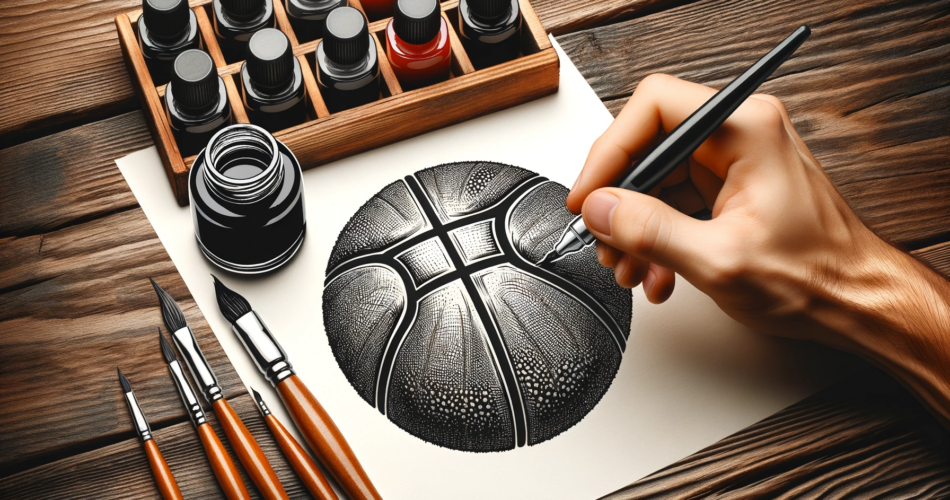Table of Contents
Introduction
The game of basketball, with its rhythm, energy, and thrill, hinges on one central element: the basketball itself.
This iconic orange sphere, with its distinctive patterns and texture, is more than just sports gear; it’s a symbol of passion, dedication, and competition.
But how do you capture the essence of a basketball in ink? This guide will dribble you through the steps of creating a standout basketball illustration.
Key Takeaways
- Texture Matters: The surface of a basketball isn’t smooth; it’s slightly rough and has a unique pattern.
- Shading is Key: Proper shading can give the ball its 3D form and highlight its curvature.
- Details Enhance Realism: Paying attention to minor details, such as the basketball’s valve or brand logo, can elevate your illustration.
- Inking Techniques: Different inking tools and techniques can lead to varied results, from cartoonish to hyper-realistic depictions.
The Basketball in Art and Culture
The basketball, with its distinctive design and universal appeal, has made appearances in various art forms, from street graffiti to modern art installations.
Its ubiquitous nature makes it a popular choice for artists aiming to depict urban culture, sports enthusiasm, or just the simple joy of play.
The Right Tools for Inking a Basketball
- Traditional Inking:
- Dip pens: Ideal for detailing and creating the basketball’s pattern.
- Brushes: Useful for shading and achieving gradient effects.
- Fine liners: Perfect for consistent lines and detailed work.
- Digital Inking:
- Graphic tablets: Devices like the Wacom Cintiq enable artists to achieve a variety of line weights easily.
- Software: Platforms like Procreate or Adobe Fresco offer brushes that mimic traditional inking tools, ideal for sports gear illustrations.
A Step-by-Step Guide to Drawing and Inking
- Sketching: Start with a perfect circle. Using a compass or a template can be helpful.
- Details: Add the basketball’s lines, ensuring they curve around the ball to emphasize its spherical shape.
- Inking: Go over your pencil lines with your chosen inking tool, ensuring consistent line weight.
Techniques to Achieve Realistic Textures
- Stippling: This technique, involving creating texture using tiny dots, is perfect for mimicking the basketball’s rough surface.
- Hatching: Use parallel lines to create shadows and depth, especially on the ball’s underside.
- Cross-Hatching: By using intersecting lines, you can achieve deeper shadows and enhance the ball’s three-dimensionality.
Enhancing Your Basketball Artwork with Background Elements
Consider adding elements like a basketball court, a hoop, players, or even cheering crowds to give context to your illustration.
These additions can transform your artwork from a mere depiction of sports gear to a narrative piece.
Conclusion
Inking a basketball is more than just capturing a sports item; it’s about illustrating a symbol of passion, team spirit, and competition.
FAQs on How to Ink a Basketball
With the right techniques and a touch of creativity, your basketball illustrations will not just depict a ball, but the spirit of the game itself.
Q: Can I use colored inks to bring out the basketball’s orange hue?
A: Yes, colored inks can add a vibrant touch to your illustration. Using orange ink can help capture the basketball’s signature color, while darker shades can be used for shading and detailing.
Q: How can I depict a basketball in motion, like during a bounce or a shot?
A: To show motion, use dynamic lines or “motion lines” trailing behind the ball. Slight distortions or an elongated shape can also give the illusion of a basketball in rapid movement.
Q: I’m planning to ink a vintage basketball. How is it different from the modern ones?
A: Vintage basketballs often had a laced-up section and were made of brown leather. When inking, focus on these distinct features, using detailed strokes to bring out the laces and the aged leather texture.
Q: Is there a difference in inking indoor versus outdoor basketballs?
A: Yes, indoor basketballs typically have a smoother texture and are often lighter in color. Outdoor basketballs, on the other hand, have a rougher surface to withstand asphalt or concrete courts. Adjust your texturing techniques accordingly.
Q: How can I integrate branding or logos when inking basketballs without it looking out of place?
A: When adding logos, ensure they follow the ball’s curvature to maintain realism. Place them where they’re typically found on real basketballs, and use a lighter hand to make sure they don’t overpower the overall illustration.



